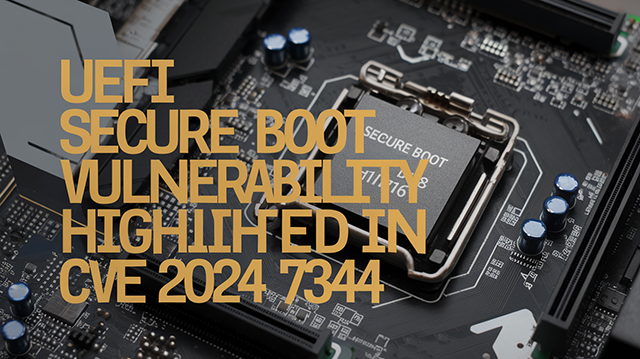UEFI Secure Boot Vulnerability Highlighted in CVE 2024 7344

Threat Group: N/A
Threat Type: Vulnerability Exploitation
Exploited Vulnerabilities: CVE-2024-7344
Malware Used: Custom PE Loader with Encrypted Payload
Threat Score: High (9.2/10) – Due to its ability to bypass foundational security mechanisms like UEFI Secure Boot, enabling undetectable and persistent compromises.
Overview
CVE-2024-7344 is a critical vulnerability found in Microsoft-signed UEFI applications, enabling attackers to bypass Secure Boot protections and execute unsigned code during system startup. This flaw arises from the use of a custom PE loader instead of standard UEFI functions, allowing the loading of unsigned UEFI binaries. Exploitation of this vulnerability permits the deployment of stealthy and persistent UEFI bootkits that can survive operating system reinstallation and evade traditional security measures.
The vulnerability affects multiple real-time system recovery tools from vendors such as Howyar Technologies Inc., Greenware Technologies, and Radix Technologies Ltd., which integrate the flawed UEFI application. Systems enrolled with Microsoft’s third-party UEFI certificate authority are at risk. In response, affected vendors have released patches to mitigate the vulnerability, while Microsoft has revoked the compromised binaries as part of its latest security updates.
Key Details
- Delivery Method: Attackers with administrative privileges can replace the default OS bootloader on the EFI partition with a vulnerable binary (‘reloader.efi’) and introduce a malicious ‘cloak.dat’ file. This setup allows the execution of unsigned code during boot.
- Target: UEFI-based systems with Microsoft’s third-party UEFI certificate authority enrolled. Affects various real-time system recovery tools from multiple vendors.
- Functions:
- Loading unsigned UEFI binaries during system boot.
- Deployment of persistent UEFI bootkits.
- Evasion of operating system-level security measures.
- Obfuscation: Utilizes a custom PE loader (‘reloader.efi’) to decrypt and load binaries from an encrypted ‘cloak.dat’ file, bypassing standard Secure Boot validations.
Attack Vectors
Exploitation of this vulnerability requires administrative privileges. An attacker can replace the system’s bootloader with the vulnerable ‘reloader.efi’ and place a malicious ‘cloak.dat’ file in the EFI partition. On system restart, the custom loader executes the malicious binary, bypassing Secure Boot and compromising the system at a fundamental level.
Mitigation and Prevention
- User Awareness: Educate users about the risks of unauthorized administrative access and enforce strict security protocols.
- Email Filtering: Implement robust email filtering mechanisms to prevent phishing attacks that could grant attackers administrative privileges.
- Antivirus Protection: Ensure antivirus solutions are updated to detect threats associated with this vulnerability.
- Two-Factor Authentication (2FA): Enforce 2FA for administrative accounts to minimize unauthorized access.
- Monitor Logs: Regularly review system and security logs for unusual activities, such as unexpected modifications to the EFI partition.
- Regular Updates: Apply the latest security patches from Microsoft and update affected third-party software to versions addressing this vulnerability.
Risk Assessment
This vulnerability poses a significant risk due to its ability to bypass critical security mechanisms, allowing undetectable and persistent system compromises. While administrative privileges are required to exploit the vulnerability, the potential impact underscores the necessity of strict access controls and vigilant monitoring.
Conclusion
The discovery of CVE-2024-7344 highlights the importance of robust security measures and continuous monitoring of system integrity. Organizations must apply patches promptly, educate users on security best practices, and enforce strict access controls to mitigate the risks associated with this vulnerability. Vigilance and timely action are essential to safeguarding systems against such threats.
Sources
- NIST - CVE-2024-7344 Detail
- ESET Research - Under the cloak of UEFI Secure Boot: Introducing CVE-2024-7344
- Ars Technica - Microsoft patches Windows to eliminate Secure Boot bypass threat
- The Hacker News - New UEFI Secure Boot Vulnerability Could Allow Attackers to Load Malicious Bootkits
- BleepingComputer - New UEFI Secure Boot flaw exposes systems to bootkits, patch now


